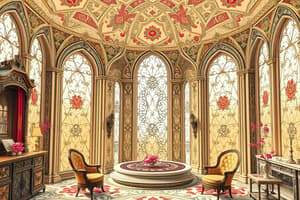Podcast
Questions and Answers
What is the purpose of a use case diagram according to the text?
What is the purpose of a use case diagram according to the text?
- Describing the system and interactions with actors (correct)
- Providing a detailed design of the system
- Describing the development methods
- Listing typical errors in system design
In a use case diagram, what do the actors represent?
In a use case diagram, what do the actors represent?
- Software developers
- System functionalities
- Coding languages used
- Customers and stakeholders (correct)
How do use case diagrams help in the analysis and design process?
How do use case diagrams help in the analysis and design process?
- Describing the best practices
- Providing a list of errors to avoid
- Answering questions about the system and actors (correct)
- Defining software development methods
Which of the following is NOT a typical element in a use case diagram?
Which of the following is NOT a typical element in a use case diagram?
What aspect do relationships between use cases in a diagram illustrate?
What aspect do relationships between use cases in a diagram illustrate?
Who are considered essential stakeholders in use case diagrams?
Who are considered essential stakeholders in use case diagrams?
In a use case diagram, what does the 'Association' notation represent?
In a use case diagram, what does the 'Association' notation represent?
Which notation in a use case diagram signifies the required use of one use case by another?
Which notation in a use case diagram signifies the required use of one use case by another?
What does the 'Generalization' notation in a use case diagram indicate?
What does the 'Generalization' notation in a use case diagram indicate?
Which element separates the system from the users in a use case diagram?
Which element separates the system from the users in a use case diagram?
What is the purpose of the 'Unit of functionality of the system' in a use case diagram?
What is the purpose of the 'Unit of functionality of the system' in a use case diagram?
What is the role of the Primary actor in a use case diagram?
What is the role of the Primary actor in a use case diagram?
What is the role of the Secondary actor in a use case diagram?
What is the role of the Secondary actor in a use case diagram?
How are actors connected with use cases in a use case diagram?
How are actors connected with use cases in a use case diagram?
What does the <> relationship signify between two use cases?
What does the <> relationship signify between two use cases?
In a <> relationship between two use cases, what happens?
In a <> relationship between two use cases, what happens?
What is the defining characteristic of an association in a use case diagram?
What is the defining characteristic of an association in a use case diagram?
Flashcards are hidden until you start studying
Study Notes
Purpose of Use Case Diagrams
- Outline functional requirements of a system by illustrating interactions between users and system functionalities.
- Serve as a visual representation to enhance understanding of system behavior.
Actors in Use Case Diagrams
- Represent users or external systems that interact with the primary system.
- Can include both primary actors who initiate a use case and secondary actors that support it.
Use Case Diagrams in Analysis and Design
- Facilitate communication among stakeholders, ensuring a shared understanding of requirements.
- Help identify system functionality and user interactions early in the design process.
Typical Elements Not Found in Use Case Diagrams
- Non-functional requirements or performance metrics are not typical elements depicted.
Relationships Between Use Cases
- Illustrate how different functionalities are connected and interact with one another.
- Help in clarifying dependencies and interactions within the system.
Essential Stakeholders
- Include primary and secondary actors, developers, project managers, and end-users who have a vested interest in system functionality.
Association Notation
- Represents a direct communication link between actors and use cases, indicating interaction.
Required Use of One Use Case by Another
- Denoted by "Include" relationship, indicating that one use case is invoked within another.
Generalization Notation
- Indicates an inheritance relationship among use cases or actors, allowing for shared behaviors or attributes.
System Boundary in a Use Case Diagram
- Represented by a rectangle that separates system functionalities from user interactions.
Unit of Functionality
- Refers to distinct functionalities or services provided by the system, represented as use cases in the diagram.
Role of Primary Actor
- Initiates an interaction or use case with the system to achieve a goal.
Role of Secondary Actor
- Provides support or assistance to the primary actor, typically not initiating interactions.
Connecting Actors with Use Cases
- Done through association lines, demonstrating how actors engage with specific functionalities.
<< Include >> Relationship
- Signifies that one use case includes the behavior of another use case, promoting reuse and modular design.
<< Extend >> Relationship
- Allows a use case to extend the behavior of another use case, adding conditional or optional functionalities.
Defining Characteristic of an Association
- Represents a bidirectional relationship between an actor and a use case, indicating mutual participation in the interaction.
Studying That Suits You
Use AI to generate personalized quizzes and flashcards to suit your learning preferences.




